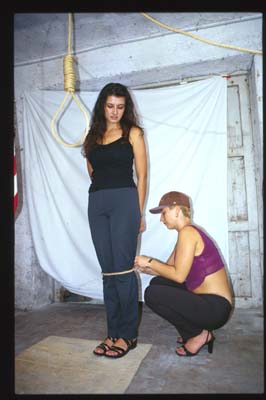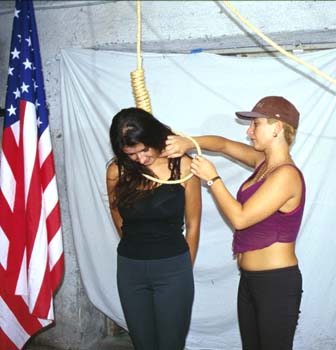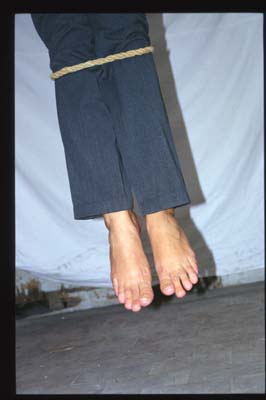 |
 |
 |
 |
 |
 |
Diana Clayton was born on the 6th of September 1920 in Milford, Delaware,
she was the first of five brothers and two sisters.
In 1929 the explosion of the Great Crisis make the factory where
her father worked, close.
To go on her parents were obliged to work as farmers, but with the
small amount of money they got they hardly managed to feed.
Diana, being the eldest, stayed at home to look after her brothers
and her younger sister.
Just to make things worse, a year after her father died of a heart
failure.
When she was 16, Diana found her first job as a housekeeper with
a family from Dover.
When she was 20 she went back to Milford, where she found job as
a waitress in a hotel.
In 1941 she met and married her first husband, Bob Miller, with
whom she had two children.
Their marriage was not happy. Bob used to spend a lot of time outside
and often had problems with the Police. At the end of 1944 she got divorced
from him while he was in jail.
In June 1946 Diana met John Warren, a thirty year older man, but
despite the age difference they had a lot of things in common. They both
had a failed marriage and two children. Those similarities were the base
of a tight relationship and when John asked her to go and live with him,
Diana accepted.
With him she moved to Wilmington and they got married on the 6th
of September of the same year, exactly on her twenty sixth birthday.
John had a steady job as station chief and for the first time in
her life, Diana had an economical stability.
For a while their marriage seemed idilliac, but then the silly discussions
started and day by day they happened more often and more violent.
One day she confessed to her sister Elizabeth: "I hate that man.
I just married him because of interest.I would like to give him a slow
death". She promised her that her next marriage would have been with a
young man that she had loved seriously.
In March 1947 her husband and she took a tenant, Billy Carson, a
twentytwo year old boy who worked at the railway station.
He, young and vigorous, was just what Diana was waiting for.
Shortly after his arrival, she often visited him in his flat and
the more time she spent with him the more in love she was.
One day she confessed him that she wanted with all her strenght
to get rid of her husband.
The boy asked her: "Since you don't love him get divorced why should
you kill him?".
"Afterwards I couldn't stand to see him with another woman" she
replied.
At the end of the summer their marriage got to such a hostility
that Diana refused to sleep in the same bed.
Saturday 27 September 1947.
That morning Diana went to a chemist and bought some ratkiller.
She was informed by the owner, Mr Robert Munce, who told her that
the package was made of arsenic, a very strong poison that shoul have been
keept put of the reach of the children and pets. Dianathanked him and ensured
him that she would have been vey carefull in handling it.
Then she signed the poison register (compulsory for anyone who buys
them) and on monday John started to feel the first stomach cramps. The
day after when Doctor Kent went there, he was not fine at all. The Doctor
saw a gastoenteritis and told him to get some antibiotics.
On wednesday morning, Mrs Warren phoned Doctor Kent to tell him
that her husband was getting better. The Doctor told her to keep on following
the treatment and to let him know about any progresses. The day after the
Doctor went to visit John and although he still had some stomach cramps
and general nausea, his conditions didn't seem so grave.
After he had visited him he told him he would have got well very
soon.
Five days after, in the morning of the 7th October, the Doctor was
called again.
This time John's conditions had got worse and worse. His tongue
was white and swallon, in addition he had diarrhea and vomiting attacks.
None of these syntoms had risked the patient's life, but anyway
Doctor Kent suggested to Mrs Warren to move him to the General Hospital,
to be observed either that night or the day after as soon as a bed would
have been available.
Diana told Mrs Pierce, her neighbour, that her husband would have
soon died and how much money she would have cashed by the life insurance.
(As a matter of fact John had drawn a life insurance of $ 2500 in favour
of Diana just a month after their marriage).
That afternoon, Elizabeth, Diana's sister, who lived in the same
street went to visit her brother in law. John was so sick that he couldn't
even drink a glass of water.
Elizabeth told Diana to move her husband to the hospital immediately
since the grave conditions, but she replied that she had not to worry.
In the early morning of eight of October, John died.
Doctor Kent was called to certify his death. He notified that he
had died because of a heart failure due to gastoentiritis.
Some days after John's premature death Detective Daniel Warren,
by chance, heard the news, Mrs Pierce's nephew. The man was not related
to the dead, but having the same surname, he felt attracted to the case
and he started to investigate officially.
Two weeks after John Warren's death, the Police with a serching
permitt went to Diana's place, aiming to discover whether there were some
poisons hidden.
Analysis on some boxes found in the kitchen were made, but they
all had negative result.
Then all chemists of the town were visited. For many hours they
had been looking for Diana Warren's name in the poison purchase register,
and finally they found it in Union st. chemist. Diana, when faced
with the evidence, declared to the sheriff that she had bought arsenic
suggested by her husband to kill some rats, but had afterward trown it
away because she tought it was too dangerous to be kept in the house with
the children around.
On November 12th, just one month after the burial, John Warren's
corpse was exumed to undrego autopsy at the Legal Medicine Department.
The analysis underscored consistent proof of arsenic in his liver,
kidneys, hair and in the victim's finger nails. There were enough evidences
to demonstrate that a lethal dose had been given at eleven o'clock pm the
day before his death that means on October the 7th.
On November 22nd Diana was arrested and found guilty of the murder
of her husband.
The trial started on May the 7th 1948 at the Penal High Court of
Dover, it lasted eight days.
The plaintiff declared herself not guilty, despite the strong evidences
against her.
During all trial she continued vociferously to deny all accuses
that had been addressed to her.At a certain moment she even tried to accuse
her sister Elizabeth, who had gone to pay a visit to her during the 7th
October afternoon, she said that ever her had the possibility to poison
her husband.
The prosecutor addressing her: "Do you want to claim that it was
your sister to give him the dose?".
"No I don't, I'm not going to testify something I'm not sure about".
"Then you husband committed a suicide?". "I can't be sure".
"Since it was not a suicide and neither you nor anybody else did
that who was it?".
Diana had a break and then started crying.
The trial ended on May 14th. Diana was found guilty of murder. After
the reading of the verdict, her barrister asked the Court to be clement
since she had had a very
difficult childhood, but the judge didn't consider it at all.
Addressing the plaintiff he asked her: "Before I read the sentence
do you have anything to declare to the Court?". "Yes I want to go
back home, because I'm innocent" replying shouting.
The judge read the sentence: "This Court sentences Mrs Warren to
be hung until death comes, as predicted by our State law. Can Lord
have mercy for your soul".
Diana, almost fainting: "Please have mercy for me, please do it
for my children".
Diana Warren was executed on December the 6th 1948 and only shortly
before been brought to the gallows she confessed her crime.
 |
 |
 |
 |
 |
 |



 |
 |
 |
 |

CONCLUSION
Diana Warren wouldn't have been found guilty of her husband's murder
if she had been calm after she had poisoned him. Hers would have been a
perfect murder and she could have cashed $ 2500, but things went different,
she started talking to too many people and at the end she was discovered.
I should point out that, during the trial, Diana claimed that Bill
seduced her and convinced her to kill,
but then it came up that their relationship had finished three months
before John's death.
Perhaps she hoped to ruin Carson, making him look guilty of the
murder.Anyway the autopsy reports proved that the fatal dose of arsenic
had been given at 11 pm of the night before, when only she could have had
the possibility to poison him.
Diana ended up making herself guilty, in other words she was: "The
woman who talked too much".

THE TOMBSTONE
+
Diana Warren
1920 1948
REST IN PEACE
THE END
Arsenic, the poison used by Diana to kill her husband, is a metal
element that looks like a white dust very similar to sugar. It was used
a lot in the past to commit murders because intoxication symptoms, such
as stomach cramps, diarrhea, vomiting, could be caused by other diseases
such as gastroentiritis and dysentery.
The poison dissolved in water or coffee, can be given in small
quantity.
The victim, according to the dosage, gets sick slowly, gets weaker
and dies without any suspicion. Only autopsy can estabilish that death
was caused by poisoning.
A 130 mg dose is considered to be fatal for an adult of medium size.
ATTENTION
The story is invented, whatever referements to real facts is to be
consider totally casual.
The model is over 18. Death scenes are a fiction .
Author of the story and of the photos: Antonio di Gennaro.
Photos must not be published on other web sites.
2000 - Copyright by ANTONIO DI GENNARO